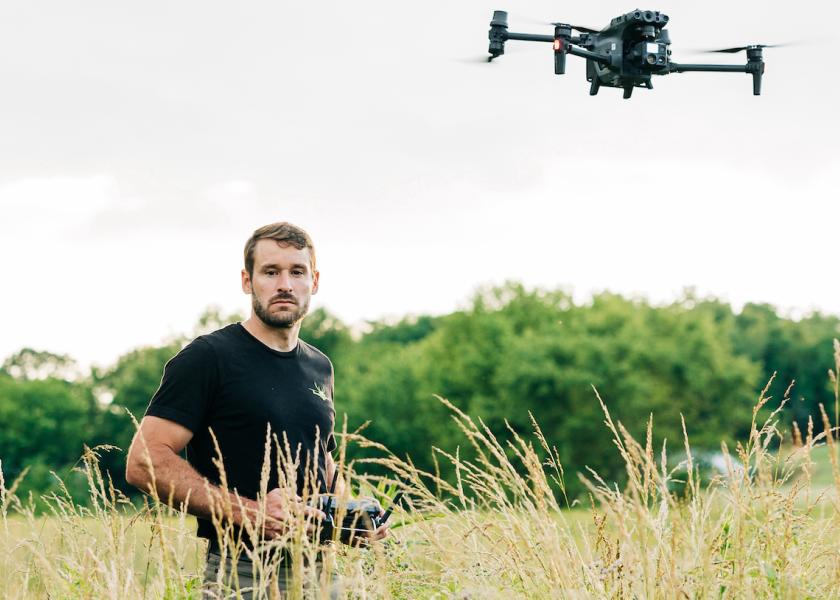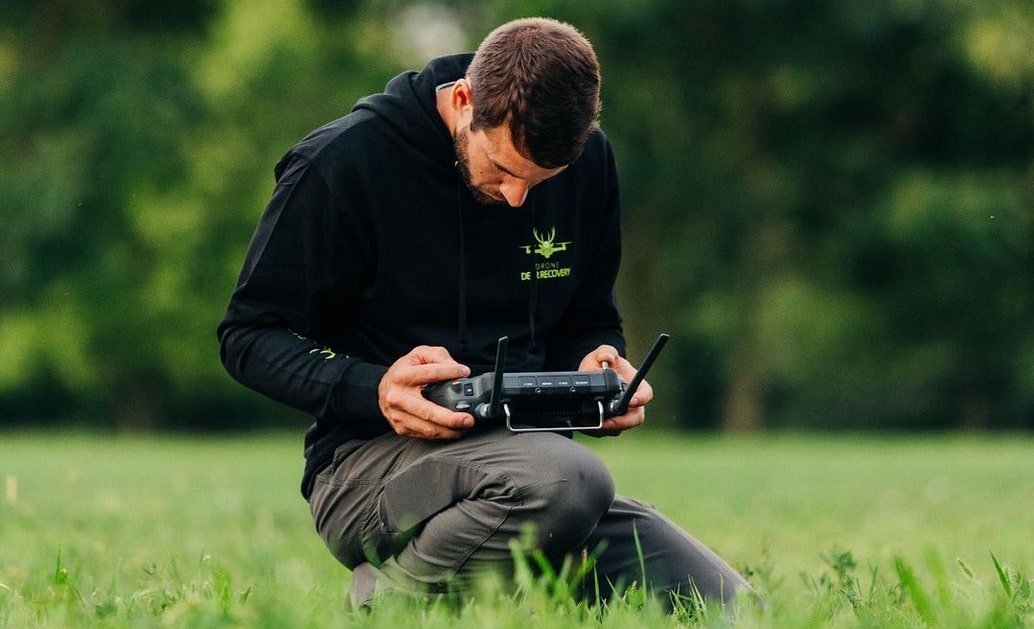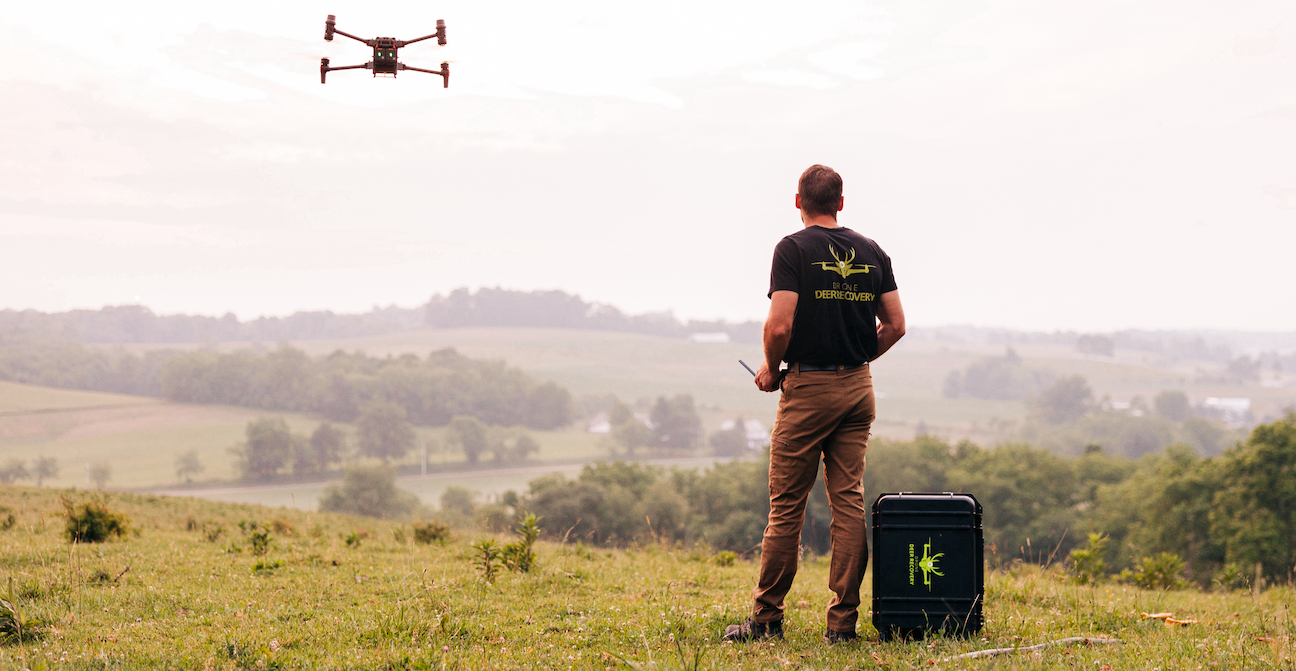Drones for Deer Recovery? Landmark Legal Fight Pits Hunters vs Government

Drones for me, but not for thee? Hunters have a right to use drones in recovery of downed deer, says Mike Yoder, and that right is anchored in the First Amendment.
A bellwether legal fight is underway that pits hunting, freedom of speech, and entrepreneurship against the bounds of government control. Michigan, along with many other states, insists drone use on private or public land is illegal in all hunting-related action, including location of downed deer.
Yoder has filed a federal lawsuit, contending he has the constitutional right to collect and disseminate information on the location of downed game—via freedom of speech. “What’s happening is government overreach. Drones handled the right way mean an end to stomping around the woods or tracking with dogs to stir up unnecessary pressure on deer,” he says. “Drones are the future of game recovery.”
Leave No Deer Behind
Raised in an Ohio Amish community, Mike Yoder typically is found spraying Midwest corn and soybean fields during crop season, but in fall 2022, he launched Drone Deer Recovery (DDR), a business aimed at using drone technology to locate downed game with a temporary eye in the sky. When DDR jumped out of the gate with heavy demand, Yoder began offering drone licensing packages and training to operator customers across the U.S.

Yoder’s services and technology are extremely effective: DDR finds the needle in the haystack.
The DDR process is standard. A given hunter contacts DDR for help in locating a downed deer. When DDR arrives on-site, the hunter signs paperwork attesting to a lost deer kill. Deploying state-of-the-art tech, DDR sends up a drone at approximately 400’, searching for the dead deer’s body heat signature with a thermal camera. Once telltale heat is detected, the drone’s 200x zoom camera checks the spot to confirm presence of a carcass, and the GPS location is collected.
DDR then passes the GPS pin to the hunter client and the deer is physically recovered.
“Probably 97% of our business is archery-related and we search roughly 800 to 1,000 yards from the track site or where the deer ran according to the hunter’s eyes,” Yoder explains. “We recover almost 100% all carcasses—that’s how great the technology works.
DDR drones deploy incredibly precise technology, detecting heat up to two days after a kill, Yoder describes. “Heat signatures from deer last according to outside air temperatures and several other variables. Ideally, if temperatures are between 30-40 F, then finding a deer 36-48 hours after a kill is very possible in daytime or night. We can search at night anytime, but we need overcast conditions to search in daytime, otherwise sunlight distorts the thermal readings.”
The entire process is minimally intrusive, Yoder notes. “We’re 400’ feet above ground level and make almost no noise—so quiet that 99% of deer in the vicinity don’t even know we’re searching. There’s no human pressure to bedding areas and no dog disruption.”
Yet, if Yoder or any hunter sends the proven drones into Michigan air above private or public land to find a dead deer, the Michigan Department of Natural Resources (DNR) responds with a penalty of up to 90 days in prison and a fine as high as $1,000. DNR claims Michigan’s “Drone Statute” bans all drone tech related to deer hunting. Period. Full stop.
(Citing ongoing litigation, DNR declined Farm Journal interview requests related to drone technology and hunting regulations.)
“DNR can use the drones to do any kind of activity it chooses, but allows no one else to do the same,” Yoder says. “Their position is ridiculous because drones can be used for the good of hunters, the state, and the overall deer population. I’m fighting for what’s right.”
Baby and Bathwater
Blocked by Michigan from operating his drone business to recover deer, Yoder filed suit in July 2023, contending DNR is actively violating freedom of speech. He is represented pro bono by the Pacific Legal Foundation (PLF).

Donna Matias, PLF attorney, describes Yoder’s position. “Mike Yoder and DDR find dead deer and create information with a GeoPin. They then convey the information to paying customers—essentially telling the hunters where the deer is located. However, Michigan DNR is preventing them from doing so and that is a direct violation of free speech and the First Amendment.”
“The importance of the First Amendment is not just related to political speech, it also protects situations where innovative technology applies—and Mike Yoder is an incredibly innovative entrepreneur,” Matias continues. “He has come up with business model that benefits hunters, wildlife, himself, and other business owners. Entrepreneurship is a fundamental right in our country and in this case, DNR violates the First Amendment and also violates Mike’s right to earn a living and to establish economic opportunities for others.”
By banning recovery of game by drone, Matias says DNR has thrown down a “broad blanket” that includes an interpretation of Michigan’s Drone Statute that prohibits constitutionally protected activity. As stated in the statute: An individual shall not take game or fish using an unmanned vehicle or unmanned device that uses aerodynamic forces to achieve flight.
According to the statute, the meaning of “take” is further detailed as: to hunt with any weapon, dog, raptor, or other wild or domestic animal trained for that purpose; kill; chase; follow; harass; harm; pursue; shoot; rob; trap; capture; or collect animals, or to attempt to engage in such an activity.
Yoder is adamant: Michigan’s Drone Statute, written in 2015, is already outdated and disconnected from technological reality. “DNR is so hard against this because it freaks them out. They had no idea the technology would develop so effectively and it’s still changing fast. Like every single technology in existence, there will always be abusers, but when you look at the amount of deer waste every single year, drone recovery benefits everyone. DNR wrote regulations without a clue about how effective the drones would become and now they won’t admit it.”
In a nutshell, believes Yoder, DNR is throwing out the baby with the bathwater.
Outlaws and Abusers
In 2023, roughly 6 million whitetail deer were legally harvested in the U.S. How many were lost to waste and never found after a kill? “The numbers of deer killed and then never found are huge,” Yoder says. “We’re talking about large, large amounts of deer wasted, and Drone Deer Recovery will make a substantial difference in lowering those waste numbers.”
“When you go nationwide and do the math, the bowhunting numbers are stunning,” Yoder continues. ‘Studies have different ranges in different states, but in some cases 50% of deer harvested are never recovered.”
The variant studies are summarized by Dr. Steven Ditchkoff, a renowned professor in wildlife ecology at the helm of the Auburn University deer research program. In a 2019 Deer & Deer Hunting article, Ditchkoff wrote:
The earliest reported studies on bowhunting wounding rates were from Wisconsin and New York, in 1958 and 1963, respectively. These earliest studies reported that 10% and 7%, respectively, of deer shot by archers were never recovered. Terminology is important here: Recovered simply means that they weren’t found by the hunter.
Other studies in Iowa and Michigan reported similar results, suggesting that bowhunting wounding rates were 17% and 12%, respectively. In contrast to these reports, six other studies from Georgia, Indiana, Michigan, New Jersey, South Dakota and Wisconsin reported bowhunting wounding rates ranging from 3% to 58%.
If we’re to believe one group of studies, then bowhunting wounding rates of deer are less than 20%, meaning that for every 10 deer hit by archers, two or fewer are not recovered. But if we’re to believe another set of studies, then one out of three or even one out of two are never recovered.
Deer recovery by drone is a help, not a hindrance, to the overall deer hunting industry, Yoder urges. “We need good people to speak up because the state’s position makes no sense. Used in the proper way and in professional hands, drone equipment helps any state maintain healthy deer numbers.”

How does Yoder respond regarding the use of drone technology by outlaws and poachers to scout or hunt deer?
“It’s like anything else: You’re always going to have bad people that hunt illegally, but they will act regardless of the law,” Yoder says. “The government is supposed to penalize the lawbreakers—not everyone else too. There will always, always be technology abusers.”
“At DDR, we stand on professionalism and engage in one thing—carcass recovery,” Yoder concludes. “We do it the right way and provide an effective and minimally intrusive means to recover lost game. It works like nothing we’ve ever had in deer hunting history and it is the future for all the right reasons, but the only one that can’t see that is the government.”
For more from Chris Bennett (cbennett@farmjournal.com 662-592-1106) see:
Priceless Pistol Found After Decades Lost in Farmhouse Attic
Cottonmouth Farmer: The Insane Tale of a Buck-Wild Scheme to Corner the Snake Venom Market
Tractorcade: How an Epic Convoy and Legendary Farmer Army Shook Washington, D.C.
Bagging the Tomato King: The Insane Hunt for Agriculture’s Wildest Con Man
Young Farmer uses YouTube and Video Games to Buy $1.8M Land
While America Slept, China Stole the Farm
Bizarre Mystery of Mummified Coon Dog Solved After 40 Years
The Arrowhead whisperer: Stunning Indian Artifact Collection Found on Farmland
Fleecing the Farm: How a Fake Crop Fueled a Bizarre $25 Million Ag Scam
Skeleton In the Walls: Mysterious Arkansas Farmhouse Hides Civil War History
US Farming Loses the King of Combines
Ghost in the House: A Forgotten American Farming Tragedy
Rat Hunting with the Dogs of War, Farming's Greatest Show on Legs
Evil Grain: The Wild Tale of History’s Biggest Crop Insurance Scam







